| |
|
|
|
|
English Family Quick Links
|
|
|
|

|
|
|
|
|
Family 40: D'Arcy Royal Mare
 |
VIEW DESCENT CHART Jenny Cameron
VIEW DESCENT CHART Kitty Fisher
This family, like many others, is rooted in the D'Arcy stud in Yorkshire and continued for several generations in the Yorkshire East Riding stud of the Appleyard family at Burstwick and Newbald and of the Bethell family stud at Rise Park, north of Burstwick, and near Beverley. Good running horses of the mid and late eighteenth century, such as Grenadier (1746), Dorimant (1772), Conqueror (1728), and Favourite (1730), some of which were also useful stallions, were early members of the family. The female line continued through two daughters of Bethell's Castaway (1704), both in the Appleyard stud. One of them had two great-grandaughters: one, Kitty Fisher (1756), the other, Jenny Cameron (1742), that took the family to America in the mid-eighteenth century. There, Jenny Cameron produced sons seen in early thoroughbred pedigrees, and Kitty Fisher became second dam of Syme's Wildair (1776), an influential sire, and also produced daughters that extended the line into the present.
The Castaway mares were out of a grey mare owned by Matthew Appleyard (1661-169-) of the manor at Burstwick Garth. Matthew was the son of Sir Matthew Appleyard (1608-1670, knighted by Charles I on the field) and Frances Pelham, a daughter of Sir William Pelham of Brocklesby Park, whose son, Charles (1625-1692, brother to Frances) is associated with the famous horse Spanker, and other early horses. Matthew jr. married Jane Ramsden, daughter of Hull merchant and alderman, William Ramsden, M.P. (1618-1680). The grey mare was by Hugh Bethell's grey son of Brimmer. Although some pedigrees say the grey mare was by either Brimmer or Son of Brimmer, published pedigrees of the period refer to Bethell's grey son of Brimmer as her sire, which agrees with both the timing and geographic location. The son of Brimmer also got Bethell's Ruffler, a winner of several cups in north country venues, born in the last few years of the 1690s, and later sire of Victorious, and Grisewood's Partner.
It was Captain Francis Appleyard, the third son of Matthew (jr.), that developed Family 40. He married Ann Taylor, the daughter of William Taylor of Norwood, and set up an establishment at North Newbald, south of Beverley and west of Burstwick Garth. Francis, like his father and grandfather before him, received income as a customs official for Kingston-Upon-Hull. He was a captain in the local army militia regiment, and was usually referred to in horse racing calendars as "Captain Appleyard."
One Castaway mare produced a filly by Wharton's Commoner, a filly, Bald Charlotte (1721, first called Lady Legs), by Captain Appleyard's stallion, Old Royal, and two colts --Quiet Cuddy (1727, by (Old/Portmore's) Fox) and Singlepeeper (1713, by Bethell's Arabian).
|
Family 40 Overview
D'Arcy Royal Mare:
Son of Brimmer Mare (f, 16--) by (Bethell's) Son of Brimmer
Castaway Mare (f, 17--) by (Bethell's) Castaway
| Singlepeeper (c, 1713) by Bethell's Arabian
| Commoner Mare (f, 17--) by (Wharton's) Commoner
| | Grey Childers [Chedworth's] (c, 1726) by Flying Childers
| | Sultan Mare (f, 173-) by (Londsdale's) Sultan
| | JENNY CAMERON (f, 1742) by Quiet Cuddy
| | Grenadier (c, 1746) by Blaze
| Lady Legs [Bald Charlotte] (f, 1721) by Old Royal
| | Chiddy (f, 1733) by Hampton Court Childers
| | | Babraham Mare (f, 1754) by Babraham
| | | Coxcomb (c, 1771) by Otho
| | | Dorimant (c, 1772) by Otho
| | Somerset Arabian Mare (f, 173-) by Somerset Arabian
| | | Buff Coat Colt (c, 1753) by Buff Coat
| | | KITTY FISHER (f, 1756) by Cade
| | | Trooper (c, 1758) by Blank
| | Cupid (c, 1736) by Somerset Arabian
| | Young Pretender (c, 1740) by Brother to Fearnought
| | Juliet (f, 174-) by Brother to Fearnought
| Quiet Cuddy (c, 1727) by Old/Portmore Fox
Castaway Mare (f, 17--) by (Bethell's) Castaway
Miss Brampton (f, 1722) by Old Royal
| Fribble (c, 1746) by Merry Andrew
Craftsman (c, 1724) by Smiling Tom
Conqueror [Devonshire's] (c, 1725) by (Old/Portmore) Fox
Conqueror [Appleyard's/Panton's] (c, 1728) by (Old) Fox
Fox Mare (f, 1729) by Old/Portmore Fox
| Dunkirk Mare (f, 173-) by Dunkirk
| Star [Norris's] (c, 1745) by Blaze
| Codgie (c,1748) by Blaze
| Romulus (c, 1750) by Blaze
Favourite (c, 1730) by (Gallant's) Smiling Tom
Long-Looked For (c, 1738) by Flying Childers
| |
The Wharton's Commoner mare produced Chedworth's Grey Childers (1726) and a filly by Lonsdale's Sultan, in turn dam of the good north country runner, Grenadier (1746) and, probably, of the filly Jenny Cameron (1742), a winner on the turf in England (won the Ladies Plate for six-year-olds at Lincoln in 1848) and America. Since the 1770s, if not earlier, Jenny Cameron was recorded as a daughter of "Mr. Witty's Cabbage-arsed mare," which eventually came to be interpreted as the famous mare in the GSB, Miss Belvoir (by Grey Grantham, Family 6), that carried the sobriquet "Cabbage-arsed mare," but Miss Belvoir was never associated with George Witty, a breeder in Beverley, Yorkshire, nor, if she was, would her dates allow her a filly born in 1742. Through process of elimination, Fairfax Harrison (Early American Turf Stock, V.I, 1934) proposed Jenny Cameron was likely a daughter of Witty's Lonsdale's Sultan mare.
In the grand Mount Airy stud of John Tayloe II in Virginia, Jenny Cameron and the filly she carried in-utero across the Atlantic (Betty Blazella, 1751, by Blaze) produced some influential sire sons. It's likely that all four of Jenny Cameron's proven sons won on the turf, but the extant records are limited to wins by two of them. (McCarty's) Silverlegs (by imp. Traveller-Jenny Cameron), was a winner at Annapolis in 1769 and Upper Marlborough in 1771; he was later dam's sire of the famous (McCarty's) Cub. His brother, (Lloyd's) Traveller (by imp. Traveller-Jenny Cameron), won in Maryland and Virginia, and as a stallion in Maryland got many daughters that bred on.
|
"The incomparable" Yorick (1760, by imp. Traveller-Betty Blazella) was unbeaten on the turf in 1764-65, and after six years in stud service he returned to the turf to win a match over five miles, carrying 12 stone-12 lbs. A well-known and popular stallion, he is seen through his daughters in many early American pedigrees. Tayloe's Tom Jones (by imp Tom Jones-Betty Blazella) won four major stakes in Virginia in 1762-63. There is scant proven evidence that Jenny Cameron had any fillies, other than Betty Blazella. Betty Blazella may have produced one filly, but Harrison notes there is no irrefutable record of the female line of these stellar producers extending beyond two generations.
Bald Charlotte and Kitty Fisher
Bald Charlotte, Singlepeeper and Quiet Cuddy were noted racehorses, and both colts were later useful stallions. Singlepeeper, a winner of the Gold Cup at York in 1719, was dam's sire of Tom Tinker (1736, by (Old) Crab), a winner of races in all four seasons he was on the turf. Appleyard's Quiet Cuddy won York's Ladies' Plate in 1732, the King's Plate at Nottingham in 1733, and several other plates, and was later a good filly-getter, sire of Mopsey (1738), winner of the Royal Plate at Hambleton in 1743, and of Jenny Cameron of this family.
Bald Charlotte first ran as "Lady Legs" under the name of William Taylor, who had sold his good galloway runner, Now-or-Never, to Appleyard. After she won the King's Plate for five year old mares at Hambleton in August of 1726, Charlotte was purchased by David Colyear, the eldest son and heir of the (1st) Earl of Portmore. She ran through 1829 for Colyear, and after his death, for his brother, Captain Charles Colyear (later 2nd Earl Portmore), picking up various prizes at Newmarket and Winchester, and possibly other wins that are unrecorded. By the early '30s she was in the stud of the Duke of Somerset, and was put to his arabian stallion, at least twice. Her first recorded daughter, Chiddy (1730, by Hampton Court Childers), won a King's Plate at Newmarket in 1739 and was later the second dam of two cracks, Coxcomb (1771) and Dorimant (1772), both by Otho. Charlotte's daughter by the Somerset Arabian produced a useful runner in Trooper (1758, by Blank), but it was this mare's probable daughter, Kitty Fisher (1756, by Cade), that continued the family line.
In analyzing the accuracy of and evidence for pedigrees relating to Kitty Fisher in the American Stud Book, Fairfax Harrison (Early American Turf Stock, V.I) presented a strong case for the pedigree of Kitty Fisher, long associated with the Bald Charlotte family, although not in the position Harrison would suggest, and not represented in any place in the GSB and in rather too many places in the ASB.
Kitty Fisher, according to 1779 and 1794 testimony by her purchaser, Virginian Carter Braxton, was bought at the dispersal sale of John Manners, Marquis of Granby, in 1759. Braxton first certified she was out of a mare by the Cullen Arabian, that was out of Bald Charlotte, and fifteen years after that, all Braxton could say of Kitty's dam was that she was "...one of the best bred mares in England..." There is, however, evidence of a 1754 filly by Cade out of a daughter of Bald Charlotte, and this, said Harrison, "control(s) the essentials of the pedigree." After considering other elements of evidence -- including a large discrepancy between the Cullen Arabian covering dates and Charlotte's productive years -- Harrison concluded Kitty was likely the daughter of the grey Somerset Arabian mare who is listed in the GSB as out of Bald Charlotte and the dam of a grey 1753 colt by Buffcoat.
As to Kitty's produce, in addition to her proven offspring, there are a half-dozen additional foals attributed to her in the ASB, which should have been listed under her daughters, and likewise there are misassigned offspring between the many Young Kitty Fishers in the female line. Harrison's corrected list, based on turf registers and advertisements, is noted in the descent chart. Her confirmed sons Wormeley's King Herod (by imp. Fearnought) and Virginia Cade (1775, by Lightfoot's Partner) are important in early American pedigrees. Of her daughters, Chamberlayne's Young Kitty Fisher by imp. Vampire is the most significant in present day pedigrees. Nancy Norman (1821, by Tom Tough), descended from Young Kitty Fisher's (by imp. Vampire) daughter by imp. Oscar is prominent in this line. After eight foals produced for her breeder, Nancy Norman ended up in the famous Virginia stud of Major Thomas Doswell, a noted horseman, breeder and trainer, where in 1839 she bred Emily Thomas (by imp. Priam) and several other youngsters by high-class sires. Emily Thomas' line dispersed across the eastern seaboard and into Canada. Another Kitty Fisher daughter, Randolph's Young Kitty Fisher (by imp. Jolly Roger), was dam of the celebrated stallion Syme's Wildair (1776 by imp. Fearnought).
Whence Boston and Tuckahoe's Female Line?
The famous American racehorse and sire, Boston (1833, by Timolean), and his dam's brother, Tuckahoe (1808, by Ball's Florizel), a noted running horse in Virginia, the American Derby winner Dodge (1913, by Jim Gaffney), and his stakes-winning near-relatives Flora Pomona (1899) and Batts (1901) descend from a mare by imp. Clockfast. Clockfast was covering mare in Virginia between 1785 and 1788 in the stud of Robert Walker of Dinwiddie County and after, apparently North Carolina. The Clockfast Mare produced a filly by imp. Alderman (who covered in both Virginia and North Carolina) in 1799 for William Randolph (of Cumberland). The filly was purchased by John Wickham of Richmond, Virginia, "in 1802 or 1803" from William Randolph's brother, John Randolph, of Tuckahoe. Wickham was told the Alderman filly was descended from (Syme's) Wildair (also of Family 40), and in a later testimony in the American Turf Register (1830) confirmed the Alderman filly was out of a mare by (Syme's) Wildair. That is all that was known to her owner, Wickham, and to turf historians, and is still all that is known, other than the list of the Alderman mare's foals, which Wickham provided the American Turf Register.
Later, S.D. Bruce, compiler of the American Stud Book, on no known evidence, extended Wickham's Alderman Mare's pedigree (ASBI p161): Alderman Mare (1799): Clockfast Mare: (Syme's) Wildair Mare: Mare by imp. Fearnought: imp. Kitty Fisher. Some modern pedigrees provide this interpretation.
In the same volume of the ASB (ASBI p 588), Bruce listed a Kitty Fisher (Hoskins') by Syme's Wildair, "bred, it is supposed, by John Hopkins, of Virginia, and owned by him." This mare's dam, confirmed by Harrison (Early American Turf Stock V.I), was by imp. Vampire and out of imported Kitty Fisher. The (Hoskins') Kitty Fisher was the dam of the good American stallion Melzar (by imp. Medley) and some other horses, but Bruce appended additional foals to her entry, including another 1799 filly by imp. Alderman, called Kitty Fisher, and provided an entry for the Kitty Fisher by imp. Alderman below her dam, with three produce listed, none of which are any in the list provided by Wickham for his 1899 imp. Alderman mare. Some modern pedigrees have adapted this line, inserting the Clockfast mare into it, viz. (Wickham's) mare by imp. Alderman: Mare by imp. Clockfast: Mare by (Syme's) Wildair: Mare by imp. Vampire: imp. Kitty Fisher. There is no evidence to support this proposal, either.
The Other Castaway Mare
This mare in Captain Appleyard's stud produced several good winners, the best the notable gelding Conqueror (1728, by (Old/Portmore's) Fox, see below), who was sold to Newmarket owner/trainer/breeder Thomas Panton, and later passed into the hands of the Viscount Weymouth; he won every Royal Plate he contested, a famous match against Looby at Newmarket and other races through age eight. Appleyard's dark grey colt, Favourite (1730, by Smiling Tom), was another good one that won the King's Plate at Ipswich in 1734, the Ladies Plate at Knavesmire, and other races. A daughter of the Castaway mare, Miss Brampton (1722, by Old Royal), was sold to Sir Edward O'Brien and sent to his stud in Ireland, where she produced Fribble (1746, by Merry Andrew), a winner of numerous races in County Clare and County Galway. Craftsman (1724, brother to Favourite), the Devonshire Conqueror (1725, brother to Panton's Conqueror), and Long-Looked-For (1738, by Flying Childers) were also all winners.
|
|
|
FAMILY #40 NOTABLE DESCENDANTS
|
|
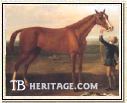 |
Bald Charlotte
|
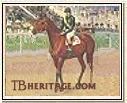 |
Bonniefield
|
 |
Boston
|
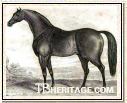 |
Carolinian
|
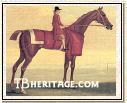 |
Conqueror
|
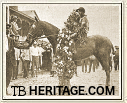 |
Dodge
|
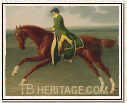 |
Dorimant
|
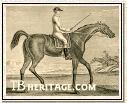 |
Grenadier
|
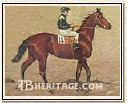 |
Inferno
|
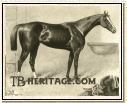 |
Ramapo
|
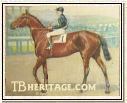 |
Victorious
|
|
Bald Charlotte ch. f. 1721
(Old Royal - mare by Castaway)
Mare from which most of the family descended in tail-female, she was a good runner and successful broodmare. She was bred by Captain Francis Appleyard in Yorkshire's East Riding, she won at Hambleton under the name Lady Legs and then went to Newmarket, winning there. Her recorded foals were all bred by Charles Seymour, Duke of Somerset; daughter Chiddy, winner of the King's plate at Newmarket in 1739 bred on, but the bulk of the family extends from a daughter, probably by the Somerset Arabian, who produced Kitty Fisher (1756, see below), a famous broodmare with significant influence on early American bloodstock. Charlotte's half-brother, Quiet Cuddy (1727, by Fox) won a royal plate at Nottingham and the Ladies' Plate at York, where he also ran in other races. He was later a useful stallion for Appleyard, and got Jenny Cameron (1742, "out of a famous mare of Mr. Witty's"), who won both in England and the U.S. after her importation into Virginia by John Tayloe II; Jenny and her daughter, Betty Blazella (imported in utero) established an important early family that produced good runners and noted stallions.
|
|
Bonnie Braes b. f. 1865 [Kitty Fisher Line]
(Balrownie - Pasta)
Bred by J.S. Watson of New Jersey, out of Pasta, by Revenue, she won Belmont's 1-1/2 mile Ladies Handicap before retiring to stud, and was sold after producing a couple of foals to John Forbes of Woodstock, Canada, where she became an extremely influential broodmare of the latter 19th century. Her produce included Bonnie Bird and Bonnie Duke, both winners of Canada's Queen's Plate; Bonnie Vic, dam of Queen's Plate winner Victorius (see below), second dam of Bonniefield, also a Queen's Plate winner, and third dam of the great Canadian runner Inferno (see below). Her sister, Bonnie Doon (1864) was second dam of American champion Ramapo (see below). Daughter Bonnie Bird was the dam of Bonnie Dundee (1890) and Nancy Lee (1891), both winners of Canada's Breeder Stakes, and Nancy Lee later produced Kelvin (1904, by Martimas), who won the King's Plate in 1907. Her sister, Bonnie Lass (1866) won the Nursery Stakes.
|
|
Bonniefield br. g. 1892 [Kitty Fisher Line]
(Springfield - Bonnie Ino)
Bred by Joseph Seagram at his Waterloo, Ontario, farm in Canada, Bonniefield was one of 15 Canadian royal plate winners he owned between 1891 and 1919. Seagram, a member of the Canadian parliament (1896-1908) and president of the Ontario Jockey Club (1906-1919) was a powerhouse owner and breeder of race horses in North America, with his runners frequently raiding south of the border. Bonniefield won both the Queen's Plate and the important Canadian Breeders' Stakes in 1895. His third dam was the influential Canadian broodmare Bonnie Braes.
|
|
Boston ch. c. 1833 [Kitty Fisher Line (?)]
(Timoleon - mare by (Ball's) Florizel)
Considered America's first great racehorse, had a seventeen race winning streak between the ages of three and six (usually over 3 or 4 miles), and was still winning up to age ten, when he retired to stud. Leading sire between 1851 and 1853, and second to Glencoe in 1854, he got the great runner and sire Lexington and Lecomte in his crop of 1850; his daughter Nina was a top racemare at distances between 2 and 4 miles and in the stud produced the champion Planet and Belmont Stakes winner Algerine, and another daughter, Madeline, was the dam of the great producer Maggie B.B. |
|
Carolinian b. c. 1815 [Kitty Fisher Line]
(Sir Archy - Old Poll by Druid)
A muscular dappled bay that stood close to 16 hands, he was bred by Major Phil Claiborne of Setwood, Brunswick County, Virginia, one of the numerous descendants of Kitty Fisher. He won seven of eight notable races, including the Great Post Stakes at Drummondsburgh, at age three, where he beat the famous horse Virginian and another good one, Quickstep, and a match against the celebrated mare Lady of the Lake in two mile heats at New Hope, near Halifax, VA. Injured, he retired to stud for three seasons in Virginia, and then returned to the turf in 1823, when he won three races in North Carolina "against many fine horses." A useful stallion that saw few "blood mares," he left winners in Virginia, North Carolina, Tennessee, and elsewhere, including Crawford, a noted runner in Georgia, Red Rover, winner of the Jockey Club Purse at Jerusalem, and Bavard. |
|
Conqueror (Appleyard's/Panton's) ch. g. 1728
((Old) Fox - mare by Castaway)
Bred by Captain Francis Appleyard near Beverley, east Yorkshire, and raced by Thomas Panton, master of the King's horses at Newmarket, and by Thomas Thynne, Viscount Weymouth, this chestnut gelding was a superior runner that won every Royal Plate he contested; at age six he won King's plates at Guildford, Nottingham, York, Lincoln, and two at Newmarket. In 1735 he beat the Duke of Bolton's Looby in a famous match (receiving 5 pounds) over four miles at Newmarket for 300 guineas. In 1736 he won 40 guineas at Bedford, 50 guineas at Bridgenorth and several other races. Records conflict regarding his dam--she was either also Bald Charlotte's dam, or a sister to her. |
|
Dodge b. c. 1913 [Kitty Fisher Line (?)]
(Jim Gaffney - Flora Willoughby by Florist)
Bred by W.F. Schulte in Louisville, Kentucky, he surfaced in the second decade of the twentieth century in the U.S. to win ten of his seventeen races at age two, placing second five times and third once. His best races were Saratoga's Saranac Stakes, the Prince George and Maryland Handicaps, and both the Latonia and American Derbies. Sold by his owner/trainer J.S. Ward at the end of his three-year-old season, purchased by A. Kingsley Macomber at auction for $17,500. Got the stakes-winning Dartle, a winner of 13 of his 46 starts, and later sire of the second dam of the notable American matron, Brighton View, the latter establishing an impressive line of stakes winners, including Olympio, Fun House, Cuvee, and Paddy O'Prado. His dam's full brother, Batts (1901) won the Clark (Stakes) Handicap and other good races in the U.S. His dam's full sister, Flora Pomona (1899) won the Gebhard Stakes in California as a juvenile, and at three took the Latonia and Tennessee Oaks, and her daughter, Flora Fina (1909, by imp Ogden) was the champion older mare in the U.S. in 1913. |
|
Dorimant ch. c. 1772
(Otho - mare by Babraham)
Bred by John Fitzpatrick, Earl of Upper Ossory, he was a great-grandson of Bald Charlotte's through daughter Chiddy, and was by the great four-miler Otho who was raced by the Earl and retired to his stud at Ampthill Park. He ran for five seasons and was unbeaten in his first two years with a fairly heavy schedule of sweeps. stakes, and matches (he won 10/10 at age 4), mostly over the Beacon Course (4 miles-1 furlong-138 yards) at Newmarket. He continued his mostly winning ways through 1779. Some of his wins included Newmarket's Great Sweep for four year olds; Newmarket's Grosvenor Stakes; Newmarket October's 1400 guineas (twice), the Oxford Cup, and the Jockey Club Plate at Newmarket. In all he won 18 out of his 26 starts, with two seconds and four thirds. Retired to Ampthill Park, he got some good runners in Dryad, Prophet, Grey Dorimant and Gabriel, and was dam's sire of Prince Le Boo, Harlequin Junior and Gentle Kitty. His brother, Coxcomb, was another good one, beat just once in nine races, his wins included the Fortescue Stakes at Newmarket and the 1400 Guineas at Newmarket October. |
|
Grenadier b.c. 1746
(Blaze - mare by Sultan)
Fairly successful north country runner bred by George Witty, owner of Merryman--winner of the important East Yorkshire Plate at Kiplingscote--and of the good runners Belinda, Milkmaid, and Meliora (dam of Tartar)), whose farm was near Beverley, Yorkshire. Grenadier beat some of the best of his era: bested Traveller and Little David (winner of Chester Gold Cup and other races) at Malton over 3 miles in heats; beat Skim over 4 miles at Black Hambleton; ran second to Skim in York's Great Subscription Purse; won the King's Plate at Newmarket in four heats beating Midas and two others, and had a walk-over for the King's Plate at Nottingham. His only other loss was York's King's Plate, when he was second to Antelope. Got some runners, but his line did not continue. |
|
Inferno b. c. 1902
(Havoc - Bon Ino)
[Kitty Fisher Line]
Bred by Canadian Joseph Seagram, his sire Havoc was a son of Himyar (also sire of Domino and Plaudit), and his dam, winner of the Queen's Plate Stakes, a grandaughter of the influential Canadian broodmare Bonnie Braes. An ill-tempered -- "dangerous to the unwary" -- but spectacular race horse and top Canadian runner between 1905 and 1908. At age 3 he won the King's Plate in his first outing, followed by the Stanley Produce Stakes and Dominion Autumn Handicap. At age four, he won five of ten races, including the King Edward Hotel Gold Cup (won again the next year) and the 1-3/4 mile Durham Cup (won again in 1908). As a five year old he won all three of his starts, the one mile Leamington and Toronto Cup handicaps and the King Edward again. His last year he won the Durhap Cup again. He left little mark as a sire. His second dam was Bonnie Ino (1886), who was also dam of Bonniefield (see above). |
|
Kitty Fisher gr. f. 1756
(Cade - mare by Somerset Arabian )
Sold by John Manners, Marquis of Granby, and imported in 1759, at age three to the U.S., by Virginian Carter Braxton. She was later a winner of some matches in her new home. Famous in her own time as a broodmare in Virginia, and celebrated matriarch there with descendants into the 1850s, afterwards with successful lines in New Jersey and Maryland, and later elsewhere in the U.S. and Canada. One of her daughters, Young Kitty Fisher, won two races at Annapolis in 1773, and sons, Braxton's Cripple (c.1770), and Virginia Cade (1775) were stallions. She was second dam of Syme's Wildair (1776), an influential stallion. Boston had 3 lines to Kitty Fisher, and Lexington 5; Bonnie Braes (above), Ramapo and Preakness Stakes winner Survivor also descend from her. Not in the GSB under her probable dam, the Somerset Arabian mare, nor under a Cullen Arabian mare that was cited in some American pedigrees. Some of Kitty's produce in the U.S. were confused with those of her many identically-named daughters, and those with each other, and some lines are not in the ASB, but are noted in the American Turf Record, via attestations.
|
|
Ramapo ch. c. 1890 [Kitty Fisher Line]
(Runnymede or Pontiac - Annie F.)
Champion older horse in the U.S., despite persistent trouble with a club foot, he was bred at J.O. Donner's Ramapo Stud near Tuxedo, New York, where his sire, imported Pontiac (by Pero Gomez) stood, and was raced by David Gideon and Marcus Daly, later sold to the Duke Brothers. Won Belmont's Champagne Stakes at age two, and after placing second a number of times at age three, won well towards the end of the season, including the Omnibus, Pelham Bay and other stakes. At age four he won the Metropolitan and Suburban handicaps and four other races of his nine starts. The following season he was laden with 150 pounds for a welter race at Morris Park. Taken to England in 1896 and did well. Moderately successful as a sire. His second dam, Bonnie Doon, was full sister to Bonnie Braes.
|
|
Survivor b. c. 1870 [Kitty Fisher Line]
(Vandal - mare by Lexington)
Bred by John Clay, he was the winner of the inaugural running of the Preakness Stakes by ten lengths for owner John Chamberlain.
|
|
Victorious b. g. 1888 [Kitty Fisher Line]
(Terror - Bonnie Vic)
Bred and raced by Joseph Seagram, he was the first of Seagram's fifteen winners of Canada's royal plate. His sire was by the Sovereign son, Ruric, and his dam, by the Vandal son Vicksburg, was a daughter of Bonnie Braes. Bonnie Vic also produced Bon Bon, the dam of Sardonic (1895 by Saragossa), who won the Latonia Oaks.
|
|
|
| |
|
|
|
|
|

